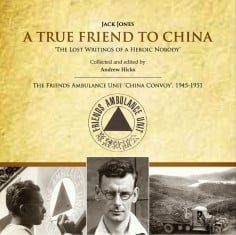
edited by Andrew Hicks
Earnshaw Books




A few years ago, British writer Andrew Hicks, a former lawyer and lecturer in Hong Kong, came across author Jack Reynolds when he was mentioned in reviews of his own novel, Thai Girl. He later discovered that Reynolds was actually a Briton named Jack Jones, who had worked in the Quakers' Friends Ambulance Unit "China Convoy" after the second world war.
Hicks went on to find detailed accounts of those years, newsletters and poetry written by Jones, the son of a vicar who ran the transport unit while based in Kunming, Chongqing and other areas. The newsletters were sent out to a handful of Friends workers sprinkled throughout the mainland and now preserved in the archives of both the Friends House in London and in an archive in Philadelphia. As such they're a great advertisement for why Hong Kong needs an archive law.
Jones describes the everyday clinics that the 400, largely British men, later American, provided with their Chinese colleagues for the impoverished population. The work was exhausting, including bone-jarring journeys across thousands of kilometres in trucks on non-existent roads to provide supplies to needy communities.
The trucks were constantly overloaded and would sometimes roll into ravines, all against the backdrop of the advance of the communists and the retreat of the Kuomintang forces.
It's this mixture of the daily challenges of the clinics and people's conditions, including scabies, mastitis, breach births, malaria, plus the long truck trips, mixed in with a stack of quality black and white photos that make this an interesting read.
Jones was often very stressed running the unit, but he was also funny at times and perceptive - although the typewritten style used for Jones' accounts makes them harder to read.
Hicks also goes on some pleasurable sidetracking. In a Hong Kong tangent, he tells us that surgeon Mary Mostyn, who only stayed a month with Jones' unit, returned to Hong Kong and later was likely the lesbian lover of doctor and author Han Suyin.
History is often defined by the higher echelons, government officials, generals in uniform, and that is also how it is photographed. But here are photos and stories of ordinary people amid poverty, disease and political tumult. There's a generous number of pictures, providing a unique view of these areas at that time.
There's one of the Shanghai Bund in 1950 shortly after liberation, another of a column of communist soldiers arriving along the road by one of the clinics.
Hicks writes of Friends workers and their Chinese colleagues leaning against trucks, treating patients, sitting round a table discussing their work, and nearly 70 years on you can identify with the men and the few women who worked with them. For some it was an enormous culture shock; others seem to have settled in very quickly.
There's a young Geoffrey Bonsall, shirtless in the heat, cradling a young dog in a team photo. He would later become the head of Hong Kong University Press.
Jones' accounts reflect the increasing nervousness as the communists come to power, and follows him as he escapes down the Yangtze River and finally arrives in tattered clothing in Hong Kong.